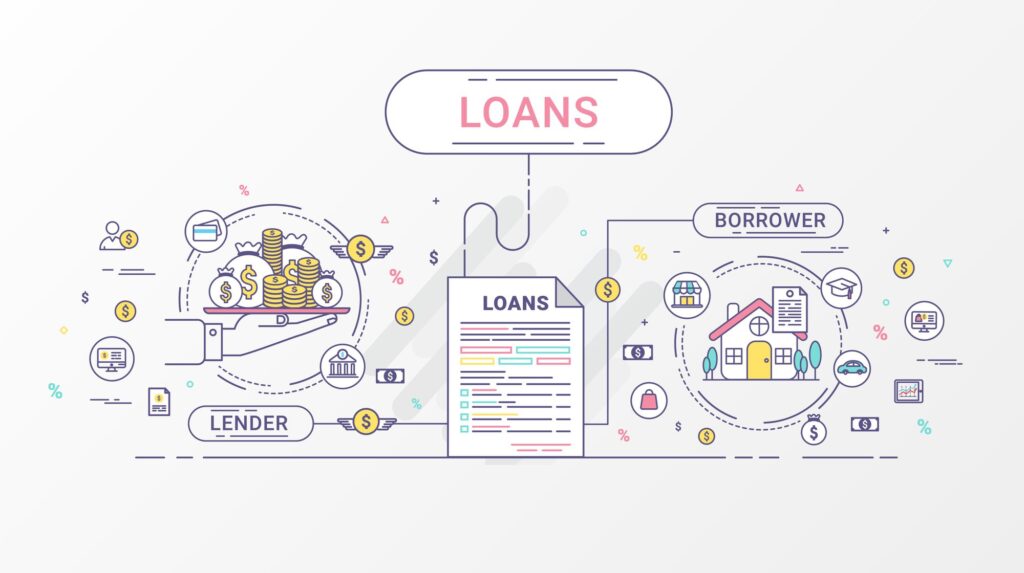Loans are a ubiquitous feature of modern financial life, serving as essential tools for individuals, businesses, and even governments to access capital for a myriad of purposes. Understanding the diverse landscape of loans, recognizing their potential benefits, and mastering the art of selecting the most suitable loan for a specific situation are all crucial skills for navigating the complexities of personal and professional finance. This comprehensive guide aims to equip you with the knowledge and insights necessary to make informed loan-related decisions.
I. Exploring the Diverse World of Loans

Loans are not a monolithic entity; they come in various forms, each tailored to meet specific needs and circumstances. They can be categorized based on several factors, including their purpose, the security they offer to the lender, and their repayment structure. Let’s delve into some of the most common types of loans:
A. Personal Loans: The Versatile OptionPersonal loans are unsecured loans, meaning they are not backed by any specific asset as collateral. This makes them a relatively accessible option for borrowers who may not have significant assets to pledge. Their versatility stems from the fact that the borrowed funds can be used for a wide range of personal expenses, providing borrowers with considerable flexibility.
- Purpose: Personal loans can be employed to address a multitude of financial needs, including consolidating existing debts, covering unexpected medical expenses, funding home renovation projects, financing travel or vacations, or handling unforeseen financial emergencies.
- Loan Length: The repayment terms for personal loans typically range from 12 to 84 months, offering borrowers a spectrum of options to suit their budgetary constraints.
- Interest Rates: Interest rates on personal loans can vary significantly, depending on factors such as the borrower’s creditworthiness, the loan amount, and the lender’s policies. The annual percentage rate (APR) can potentially reach up to 36%, highlighting the importance of careful comparison shopping.
- Credit Check: A credit check is generally a prerequisite for obtaining a personal loan. Lenders use credit scores to assess the borrower’s creditworthiness and determine the interest rate they are willing to offer.
- Collateral: As unsecured loans, personal loans typically do not require borrowers to provide collateral. However, some lenders may offer secured personal loans, which require collateral but may come with lower interest rates, presenting a trade-off for borrowers to consider.
- Benefits: Personal loans offer flexibility in terms of usage, providing borrowers with the freedom to allocate the funds as they see fit. They can also provide relatively quick access to funds, which can be crucial in emergency situations.
- Considerations: Interest rates on personal loans can be relatively high compared to secured loans, particularly for borrowers with less-than-perfect credit histories. This underscores the importance of comparing offers from multiple lenders.
B. Debt Consolidation Loans: Streamlining Your FinancesDebt consolidation loans are specifically designed to streamline debt management by combining multiple debts from various sources into a single loan. This can simplify repayment and potentially reduce interest costs.
- Purpose: These loans simplify the process of managing debt by consolidating credit card balances, personal loans, and other outstanding debts into one single loan with a unified monthly payment.
- Loan Length: Repayment terms typically range from 12 to 84 months, providing flexibility in choosing a repayment schedule that aligns with your budget.
- Interest Rates: APRs can go up to 36%, but the primary goal is to secure a lower interest rate than the average rate on the existing debts. This can result in significant savings over time.
- Credit Check: A credit check is a standard requirement for debt consolidation loans, as lenders need to assess your creditworthiness and ability to manage the new loan.
- Collateral: Debt consolidation loans are generally unsecured, meaning they don’t require you to put up any assets as collateral.
- Benefits: Simplifies debt management by reducing the number of monthly payments to track, potentially lowers interest rates, and can improve your credit utilization ratio, which can positively impact your credit score.
- Considerations: Requires careful evaluation to ensure that the new loan offers better terms than the existing debts. It’s crucial to compare the overall cost of the consolidation loan with the costs of maintaining the individual debts.
C. Mortgages: Making Homeownership a RealityMortgages are long-term loans specifically used to purchase a home, with the property itself serving as collateral. These loans are instrumental in enabling individuals to achieve the dream of homeownership.

- Purpose: Mortgages provide the necessary funds to buy a property, making homeownership accessible to a wider segment of the population.
- Loan Length: Repayment terms typically range from 10 to 30 years, allowing borrowers to spread the cost of homeownership over a manageable period.
- Interest Rates: Mortgage interest rates can be fixed or variable, with rates averaging around 7.90% for 30-year fixed mortgages. Fixed rates provide stability and predictability, while variable rates can fluctuate based on market conditions.
- Credit Check: A credit check is mandatory for mortgage applications, as lenders need to assess the borrower’s creditworthiness and ability to repay the loan.
- Collateral: The purchased property acts as collateral for the loan, providing security to the lender.
- Benefits: Enables homeownership with manageable monthly payments spread over a long period, allowing individuals to build equity in a valuable asset.
- Considerations: Requires a significant down payment, involves closing costs, and carries the risk of foreclosure if payments are not made.
D. Home Equity Loans: Tapping into Your Home’s ValueHome equity loans allow homeowners to borrow against the equity they have built up in their homes, providing access to substantial funds for various purposes.
- Purpose: Funds from home equity loans can be used for a variety of purposes, including home improvement projects, medical bills, debt consolidation, and other significant expenses.
- Loan Length: Repayment terms typically range from 5 to 30 years, offering flexibility in choosing a repayment schedule.
- Interest Rates: Interest rates can start around 7.99% APR, often making them more attractive than unsecured loans.
- Credit Check: A credit check is required to assess the borrower’s creditworthiness and ability to repay the loan.
- Collateral: The borrower’s home serves as collateral, providing security to the lender.
- Benefits: Access to substantial funds at relatively lower interest rates compared to unsecured loans, making them a cost-effective option for large expenses.
- Considerations: Places the home at risk if payments are not made, and the amount available depends on the homeowner’s equity.
E. Student Loans: Investing in Your FutureStudent loans are specifically designed to finance post-secondary education, covering tuition, room and board, books, and other educational expenses.
- Purpose: Student loans enable individuals to pursue higher education by providing the necessary funds to cover the costs of tuition, fees, and living expenses.
- Loan Length: Repayment terms typically range from 5 to 15 years for private loans and 10 years for federal loans, offering a range of repayment options.
- Interest Rates: Interest rates can start as low as 4.24% APR. Federal student loans often have fixed interest rates, while private loans can have fixed or variable rates.
- Credit Check: A credit check is generally required for private student loans, although some federal student loans do not require a credit check.
- Collateral: Student loans are typically unsecured, meaning they don’t require you to put up any assets as collateral.
- Benefits: Allows individuals to invest in their education and future earning potential, opening doors to better career opportunities.
- Considerations: Accumulating student loan debt can be a significant financial burden, especially if the borrower struggles to find employment after graduation.
F. Auto Loans: Getting You on the RoadAuto loans are used to finance the purchase of a new or used vehicle, with the vehicle typically serving as collateral.
- Purpose: Auto loans make vehicle ownership accessible by providing the necessary funds to purchase a car or truck.
- Loan Length: Repayment terms typically range from 12 to 84 months, allowing borrowers to choose a repayment schedule that fits their budget.
- Interest Rates: Interest rates can start around 4.50% APR, depending on factors such as credit score and the age of the vehicle.
- Credit Check: A credit check is required, as lenders need to assess the borrower’s creditworthiness.
- Collateral: The purchased vehicle usually serves as collateral, providing security to the lender.
- Benefits: Enables individuals to acquire vehicles for transportation with manageable monthly payments.
- Considerations: The vehicle’s value depreciates over time, and the borrower risks losing the vehicle if payments are not made.
G. Small Business Loans: Fueling Entrepreneurial DreamsSmall business loans are designed to provide funding for various business expenses, such as startup costs, working capital, and expansion.
- Purpose: These loans support entrepreneurs and small business owners in starting, operating, and growing their businesses.
- Loan Length: Repayment terms can extend up to 300 months, providing flexibility for businesses to manage their cash flow.
- Interest Rates: Interest rates can start around 3% APR, making them an attractive option for businesses seeking capital.
- Credit Check: A credit check is generally required, and lenders may also assess the business’s financial health.
- Collateral: Small business loans may require collateral, such as equipment or real estate, depending on the lender and the loan amount.
- Benefits: Provides capital for business ventures, fostering economic growth and job creation.
- Considerations: Requires a solid business plan, can be challenging to obtain for startups, and carries the risk of business failure.
II. Unveiling the Multifaceted Benefits of Loans
Loans, when used responsibly, offer a plethora of benefits to individuals and businesses alike. They can be instrumental in achieving financial goals, managing cash flow effectively, and unlocking opportunities that would otherwise be out of reach.
- Access to Capital: Loans provide access to funds that may not be readily available, allowing individuals to make significant purchases, such as homes or vehicles, and enabling businesses to invest in growth opportunities.
- Flexibility: Loans can be used for a wide range of purposes, offering flexibility to borrowers in addressing their specific needs and priorities.
- Credit Building: Responsible loan management and timely repayments can help build or improve credit scores, opening doors to better financial opportunities in the future.
- Debt Consolidation: Debt consolidation loans can simplify debt management by combining multiple debts into a single, more manageable loan, potentially reducing interest costs and streamlining repayment.
- Investment Opportunities: Loans can enable individuals and businesses to invest in opportunities that can generate returns, such as real estate, education, or business expansion.
III. Navigating the Loan Selection Process: A Step-by-Step Guide

Choosing the right loan is a critical decision that requires careful consideration and thorough research. Here’s a step-by-step guide to help you navigate the loan selection process:
- Assess Your Needs: Begin by clearly defining the purpose of the loan and determining how much money you need to borrow. Avoid borrowing more than necessary, as you will be responsible for repaying the principal plus interest.
- Check Your Credit Score: Your credit score plays a significant role in determining the interest rate and loan terms you will qualify for. Obtain a copy of your credit report and address any errors or inconsistencies.
- Shop Around: Compare loan offers from multiple lenders, including banks, credit unions, and online lenders. Pay attention to interest rates, fees, repayment terms, and any other associated costs.
- Consider Interest Rates: Interest rates can be fixed or variable. Fixed interest rates remain constant throughout the loan term, providing stability, while variable interest rates can fluctuate based on market conditions, introducing an element of risk. Choose the interest rate type that aligns with your risk tolerance and financial goals.
- Evaluate Repayment Terms: Consider the loan’s repayment term and ensure that the monthly payments fit comfortably within your budget. Longer repayment terms may result in lower monthly payments but higher overall interest costs, while shorter terms lead to higher payments but lower overall interest.
- Read the Fine Print: Carefully review the loan agreement and understand all the terms and conditions before signing. Pay attention to any prepayment penalties, late payment fees, or other potential charges.
- Seek Professional Advice: If you are unsure about which loan is right for you, consult with a financial advisor who can provide personalized guidance based on your specific circumstances.
IV. Exploring Additional Loan Options
Beyond the common types of loans discussed above, several other options cater to specific needs and situations:
- Loans Against Fixed Deposits: A fixed deposit can be used to obtain a loan, with the loan amount typically ranging between 70-90% of the fixed deposit’s value. This can be a convenient option for those who need funds without liquidating their savings.
- Loans Against Securities: Investments like shares, mutual funds, or fixed deposits can be pledged as collateral for a loan. This allows access to funds without selling off your investments, preserving their potential for future growth.
- Gold Loans: Gold jewelry or ornaments are used as collateral for a loan. This can be a quick and relatively easy way to access funds, particularly in regions where gold is a common form of savings.
- Loan Against Property: Immovable property is used as collateral to secure a loan. This can be a significant source of capital for businesses or individuals who own real estate.
Also Read : Understanding Loans: A Comprehensive Guide to Your Financial Options
Conclusion: Borrowing Wisely for a Brighter Financial Future
Loans are powerful financial tools that can help individuals and businesses achieve their goals and navigate financial challenges. By understanding the different types of loans available, recognizing their potential benefits, and mastering the art of choosing the right loan for your specific circumstances, you can make informed decisions that contribute to a brighter financial future. Remember to always borrow responsibly, compare offers from multiple lenders, and carefully consider the terms and conditions before committing to a loan. Financial literacy and responsible borrowing practices are key to harnessing the power of loans for your financial well-being.



